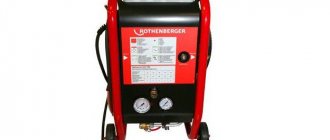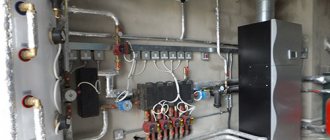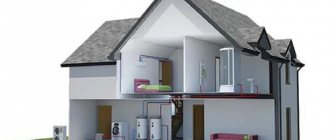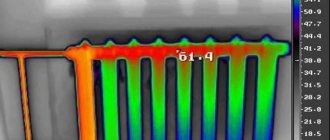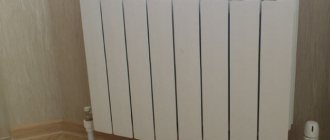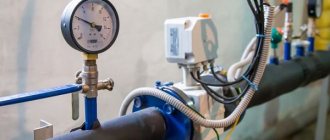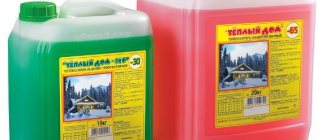Video of the subtleties of filling a closed system
By observing caution and starting rules, you can independently cope with adding water to the old system. At the first start, checking and filling should be done by the technicians who installed the heating
If you do not have the skills, do not try to fix the leak or replace the coolant in the circuit yourself. Entrust the work to a specialist - the master will select the optimal media, a cleaning agent that will not damage the internal surfaces, and will correctly fill the system.
The procedure for starting the heating of a multi-storey building.
Starting the heating of a multi-storey building is often associated with troubles arising from ignorance of the rules. To start the heating, a certain order and sequence must be followed.
The beginning of the heating season in housing and communal services is often complicated by problems of uneven heating on the upper floors of a high-rise building, as well as entire risers and apartments.
Such problems arise due to the rapid startup of the heating system. When the pipelines of a high-rise building are quickly filled, air pockets form in the system in the heating system of a multi-story building. which do not allow risers and entire apartments to warm up.
In the summer, after hydraulic testing of the pipeline. The heating system remains motionless and the pressure drops. In order to prevent the system from swallowing air and accumulating air pockets when starting up, it is necessary to follow certain rules for starting the heating system of a multi-storey building. How to properly fill the heating system with water in an apartment building, namely:
- 1. Perform a smooth launch of the coolant into the system. Turn on the make-up pumps in the central heating substation at minimum speed so that the coolant fills the system not abruptly, quickly in leaps and bounds, but slowly and gradually.
- 2. The filling of the system must be carried out through the return line of any system of a low-rise and high-rise building, that is, from the bottom up. With this filling, water, the coolant, smoothly displaces all the air that has accumulated in the system over the summer period, thus displacing the air lock from the system.
- 3. After a smooth start, it is necessary to release the remaining air from the heating system - from the air collectors located in the upper points of the multi-story building in the attic.
- 4. On the air collector, open the drain valve slightly, waiting for the characteristic whistling of air to stop.
- 5. After air stops coming out of the drain valve, it is necessary to drain the water from the heating system. to release any remaining air. Drain a small amount of water until bubbles stop coming out. Water should be drained into a bucket or any other container so as not to flood the upper floors.
- 6. In houses where there is no attic, for example, in five-story buildings, air is vented independently through Mayevsky taps on the top floor of the house. By slightly opening the Mayevsky tap with a screwdriver, the air descends and the radiator immediately begins to warm up.
Basic errors when starting the system.
- 1. Mistake #1 is to quickly start the system through the supply line.
- 2. Mistake No. 2 is draining water, the coolant, from the system in the basement. It’s an absolutely pointless thing, since the air rises up, and there’s no point in letting it down from the lower points; it won’t work out anyway.
- 3. Mistake No. 3 is draining air and water from the battery in each apartment of a multi-story building. When the system is started correctly, this procedure disappears on its own.
Watch how to bleed air from a radiator:
- When should the system be filled before heating starts after summer?
- How to properly start the heating system of 5 and 9 storey buildings
- Air lock in the heating system of a multi-storey residential building.
- Should the heating system be filled in September
Social reviews Cackl e
What types of heating systems are there for an apartment building?
Depending on the installation of the heat generator or the location of the boiler room:
- An autonomous system in an apartment where the heating boiler is installed in a separate room or in the kitchen. The costs of purchasing a boiler, radiators and corresponding materials for piping are returned quickly, since such an autonomous system can be adjusted based on your own considerations regarding the temperature regime in the house. In addition, an individual pipeline does not lose heat, but on the contrary, it helps to heat the premises, since it is laid throughout the apartment or house. An individual boiler does not need to be adapted for the reconstruction of central heating - once drawn up and implemented, the heating scheme will work for a lifetime. And finally, the already working circuit can be supplemented with parallel or sequentially connected circuits, for example, a “warm floor”;
- An individual heating option that is designed to serve an entire apartment building or an entire residential complex is a mini-boiler room. Examples include old boiler houses serving a neighborhood, or new complexes for one or more houses using different energy sources - from gas and electricity to solar panels and thermal springs;
A centralized heating scheme in a multi-storey building is still the most common working solution to the problem.
Heating schemes depending on the parameters of the working fluid:
- Heating using ordinary water, in the pipes of which the coolant does not heat above 65-70 0 C. This is a development from the field of low-potential systems, but most often old schemes work with the temperature of the working fluid reaching 80-105 0 C;
- Steam heating, where not hot water moves through the pipes, but steam under pressure. Such systems are becoming a thing of the past, and today they are practically not used in the delivery of heat and heating of any type of apartment buildings.
Based on the piping diagram:
- The most common is a single-pipe heating system for a multi-story building, where both supply and return pipes are one thread of the heating main. Such a scheme can still be found in “Khrushchev” and “Stalin” buildings, but in practice it has a big drawback: batteries or radiators connected in series to the circuit do not ensure uniform heat transfer - each subsequent heating device will be a little colder, and the last radiator will be a little colder. the pipeline will be the coldest. For at least approximately equal distribution of heat throughout the rooms, each subsequent radiator in the circuit must be equipped with a larger number of sections. In addition, in a single-pipe heating scheme in a five-story building, you cannot use radiators that do not meet the design parameters, and devices for regulating heat transfer - valves, etc. regulation;
- The Leningradka scheme is a more advanced solution, but according to the same single-pipe scheme. This scheme has a bypass (pipe jumper), which can connect or disconnect additional heating devices, thereby regulating the heat transfer in the room;
A more advanced two-pipe heating system in an apartment building began its existence with the construction of buildings according to the so-called “Brezhnevka” project - a panel house. The supply and return in such a scheme operate separately, so the temperature of the working fluid at the inlets and outlets of the apartments of a 9-story building is always the same, as in radiators or batteries. Another plus is the possibility of installing an automatic or manual control valve on each heating device; The radial (collector) scheme is the latest development for atypical housing. All heating devices are connected in parallel, and taking into account the fact that this is a closed OO system in an apartment building, the piping can be made hidden. When implementing a beam scheme, all control devices can limit or increase the heat supply in dosed quantities.
Filling the system from below
So, let's get back to pumping fluid into the system. We use a container of suitable volume (a 200-liter plastic barrel works well). We lower a pump into it, creating the pressure required for pumping liquid no higher than 1.5 atm (typical value in the range of 1-1.2 atm). Such pressure requires the pump to create a pressure of 15 m (for the submersible “Malysh” it reaches 40 m).
Having filled the barrel with water, we start the pump, monitoring the liquid level, which should be located above its inlet pipe to prevent “airing”. The level drops - add water. Antifreeze should be pumped from a smaller container (bucket) so as not to immerse the submersible pump housing in the liquid (and then wash it) - just immerse the inlet pipe. You will have to add antifreeze frequently, turning off the pump periodically.
Filling the system is carried out with Mayevsky taps open on installed heating radiators with substitute containers for collecting water. When liquid comes out of all air vents, close the taps and continue the injection process.
We control the pressure using a pressure gauge (a boiler gauge will do). When its value exceeds the hydrostatic pressure, equal to the pressure in the liquid column height from the bottom to the top point of the system (a height of 5 m gives a static pressure of 0.5 atm), we continue to fill the system, monitoring with a pressure gauge the moment the pressure reaches the required value.
Pumping antifreeze with the “Malysh” pump.
Having filled the system, turn off the pump, open the air valves (the pressure will inevitably drop), and then pump up the water. We repeat the process several times, displacing air bubbles.
We complete the filling by inspecting the system for leaks. After the pump is turned off, the liquid in the hose connected to the outlet pipe is under pressure. If antifreeze was pumped in, first disconnect the hose from the pump inlet pipe and drain the liquid into a container, being careful not to drench the mechanism body.
Coolant replacement reasons and frequency
Replacing water in a closed and open heating circuit is carried out:
During the first heating start.
After installation, the system is filled and started
After seasonal drainage.
When starting after repair work.
Regular topping up of liquid is required during operation if it has not been drained after the heating season.
Why drain your home system?
A question for which there is no clear answer is whether it is necessary to drain the circuit annually after the end of the heating season? The decision depends on the type, age and material of manufacture of the main elements - pipes and radiators, as well as on the total volume of liquid.
Each type has its own frequency of media replacement
Most often, systems with old cast iron radiators are drained for the summer. The reason is the appearance of a leak after the boilers are turned off. The old cast iron ribs are connected to each other by threaded connections with old gaskets. When there is hot water inside the batteries, the seals expand, providing a stable seal at the seams.
After the water cools, the material from which the gaskets are made naturally contracts and begins to flow at the junction of the ribs. But prolonged idle time of old radiators without water is fraught with accelerated corrosion; the rust inside the radiator and old pipes crumbles in a dry environment, and can damage the entire riser.
In closed new circuits, filling the heating system is not a costly process. But it is not recommended to completely drain the liquid every year - this is not necessary.
Frequency of replacing and topping up fluid in the heating system
How often do you need to change the fluid in your heating system? A few general rules:
In open-type circuits of private houses, it is enough to simply add water if the system is sealed, without subjecting the old communications to stress tests in the form of long dry periods. Replacement is necessary only in case of emergency repair or preventive sealing, after washing.
If a leak occurs, it is necessary to drain the water and carry out repairs.
Closed heating systems require preventive flushing and replacement of the coolant after several years.
The frequency of filling with new liquid depends on the characteristics of the water, the service life of the synthetic coolant, and the general condition of the system. If the extreme points are very airy, it is recommended to identify the cause - find the location of the leak and check the tightness of the heating network. Typically, water changes are carried out every few seasons.
Useful tips
To prevent arbitrary changes in water flow, shut-off valves are attached to the inlet-outlet area of the circulation pump. The connecting nodes must be treated with a “sealant”, this will increase the performance of the entire heating system.
To quickly and correctly install a pump pump, you need selected connections and threads. To reduce the time spent searching for all the necessary parts, look in plumbing stores for a special device with already selected fasteners. After completing the installation process of the pumping unit, the system is filled with water or other coolant.
Before starting the system, you should open the central valve to remove air pockets - the appearance of water will indicate the complete removal of air from the system.
About quantity and breakdowns
The number of circulation pumps required to heat a private house can be determined based on the entire length of the pipeline. If its length is about 80 m, then one is enough. If this length is exceeded, you need to consider increasing the number of pumps in the system.
The reasons for the failure of circulation pumps can be incorrect installation, arbitrary placement of the cable connections and terminal module, as well as non-compliance with the operating rules of the heating boiler
To avoid malfunctions, it is important not to ignore the procedures for regular air release and take care to thoroughly clean the system from mechanical particles
But it should be remembered that all breakdowns of the circulation pump must be corrected by specialists. Therefore, if faults have already appeared and are detected, then it is best to contact the repair service.
How to supplement coolant
In addition to the instructions for filling the heating system, you need to know the correct procedure for adding coolant. This situation may occur 2 or 3 times during the heating season.
It is important to determine in time that the volume of water has dropped below the critical level. Depending on the type of heating, there are different procedures for filling the heating system
Closed heating system
The main indicator is a decrease in the pressure level in the pipes. For timely monitoring, several pressure gauges are installed in the system. One of them must be located immediately after the hot coolant exits the boiler. You should also install a pressure gauge on the top air valve. The pressure drop in the system is a consequence of 2 factors - the occurrence of an emergency (leakage) or natural evaporation of the liquid. If this process happens very quickly, there is most likely a pipe break. A gradual decrease in pressure indicates the second factor.
The method of adding liquid completely repeats the procedure for filling any closed heating system with water. To do this, you can use hand pumps to fill the heating system (antifreeze), or use a central water supply connection.
Open heating system
It is recommended to fill an open heating system with water through an expansion tank. This can be done even when the water temperature in the pipes is relatively high. This method has several advantages - monitoring the coolant level in the system during filling and improving circulation due to the difference in water density.
There is a risk of failure of the boiler or heating radiators if additional filling of the open heating system with coolant occurs while the boiler is running. Therefore, this procedure is recommended to be performed when the water in the pipes reaches room temperature.
To select antifreeze, we recommend that you watch the video.
First start of the heating boiler
The procedure for starting the boiler for the first time before the start of the heating season depends on its model and type. But despite this, a visual check of its condition is performed. This is one of the most important stages preceding the final launch of heating in a private home.
The heat exchanger is one of the most “vulnerable” elements of the boiler. Checking it is mandatory, because during operation of the device it is constantly exposed to high temperatures. Along with the task of starting the heating radiator, preparing the boiler is one of the most important during the process.
Solid fuel boiler
Before the starting of the heating system has not yet taken place, a comprehensive monitoring of the condition of the solid fuel boiler is carried out. Its surface is cleaned of rust, and the functionality of the pressure gauge and thermometer is checked.
Then follow the following steps to properly start the heating system:
- Cleaning the firebox and ash pan from soot. This can be done with a metal brush;
- Checking the condition of the chimney. Its pipe must be securely connected to the boiler pipe.
For pyrolysis and pellet models, the operation of the electronic control unit, fans and nozzles is tested. When the heating system is started correctly, improper functioning of these elements can lead to sudden temperature changes, which directly affects the condition of other components.
A gas boiler
Before starting a gas heating boiler, you should read its instructions. For different models, the order of steps may vary slightly. This is due to the different types of construction. This especially applies to condensation models, in which the correct formation of condensate must be monitored during operation. Without it, heating the secondary heat exchanger will be impossible.
How to correctly start heating with a gas boiler? After filling the system with water, you need to do the following:
- There is a valve at the bottom of the boiler that shuts off the flow of water into the circuits. After the end of the heating season it can be closed. Therefore, you need to open it - the pressure gauge readings will change. The pressure value should not exceed 3 atm;
- After heating the coolant, you need to open the make-up tap again. If there are air pockets left in the system, you can remove them using Mayevsky taps. The pressure in the system may decrease slightly during this stage;
- In fact, you will have to start the heating radiator 2 times. The first - during filling with coolant, and the second - when turning on the boiler;
- The correct functioning of the boiler is controlled by the values on the dashboard.
The result of starting heating in a private house should be a stable temperature regime of the entire system, as well as the absence of pressure surges in the pipes.
What pipes are needed to connect a heating boiler?
The choice of pipes is a very important stage in preparation for the installation of heating equipment.
For efficient operation of a heating system with a circulation pump, the pipes must withstand the following indicators:
- pressure - 1-2.5 kgf/sq. cm.;
- supply liquid temperature 70-75 °C;
- return temperature - 55°C.
These are parameters that are maintained during normal operation of the system, without emergency situations.
If the pump stops for some reason, the situation will develop as follows:
- for a gas, electric and diesel boiler, the thermostat will shut off the fuel supply and the operation of the water circuit will remain safe;
- For a boiler operating on solid fuel, the thermostat will close the ash pan, but combustion (smoldering) of the fuel will continue for up to half an hour, which means that the temperature of the coolant may increase.
In this situation, the performance characteristics of plastic and metal-plastic pipes that will be used for a gas, electric and diesel boiler must have operating parameters of at least 80 °C.
As for the solid fuel unit, at least 1-2 meters of the water circuit coming from the boiler must be made of steel, copper pipes or stainless steel. Steel pipes, resistant to temperature changes and hydraulic pressure, are unfortunately susceptible to corrosion, have considerable weight and an insufficiently smooth inner surface. Installation must be done by welding. The outside of the pipes is coated with paint, and such maintenance must be done regularly. Copper and stainless steel pipes do not have such problems. The only drawback is the rather high price of these products.
With natural circulation, the heating process of the coolant occurs slowly. The temperature of the liquid leaving the boiler sometimes exceeds 90°C. Therefore, the pipeline between the boiler and the expansion tank is always made of metal.
Not even the best plastic can withstand abnormal temperatures. Leakage and plastic softening are guaranteed at 130°C. Polypropylene pipes burst due to overheating.
In recent years, attempts have increasingly been made to hide the pipeline from view. The wiring is done not only externally, but also hidden in the walls, under the finished floor, inside plasterboard boxes. In heating systems, it is permissible to combine different types of pipes.
Filling the heating system with coolant
We need to remind you once again that before starting the heating system of the house, a visual inspection of all elements is performed. If necessary, individual units and components are replaced. Only after this can you begin the procedure of filling with coolant.
In the absence of water, a small coating of rust will inevitably form on the inner walls of the radiators and heat exchanger. Therefore, before adding coolant, it is recommended to clean the system.
Flushing the heating system
If there is still coolant left in the pipes, you need to remove it. This can be done through a special pipe located at the lowest point of the system. There should also be a make-up unit there. Only after this can we continue to solve the question of how to properly start the heating system.
For closed heating circuits with forced circulation, it is recommended to do hydrodynamic flushing. To do this, you should purchase (or better yet, rent) a special pump with filtration and a chamber for cleaning liquid.
Washing procedure:
- Connecting the pump pipes to the system;
- Launch and visual monitoring of the degree of contamination of water that has flowed through the pipeline through a full cycle;
- If necessary, replace the fluid with a new one;
- Do several rinsing cycles until the water is completely clear.
After this, crimping is performed. Before starting the heating radiator, you need to check the condition of its connection to the pipeline. It is recommended to replace the gaskets and also check the integrity of the couplings.
To start a closed heating system, an increased amount of coolant (or air) is pumped into the pipeline. This is necessary to check the reliability of the system’s connecting elements. The pressure value should exceed the nominal value by 1.2 times.
Adding coolant to heating systems
You can use ordinary distilled water or antifreeze as a coolant. Filling is carried out through the sub-post assembly located at the lowest point.
This is important, since when you try to add water through other pipes located higher, the likelihood of air locks will increase. In order to start the heating battery correctly, it is recommended to check the presence of Mayevsky taps and their functionality
To do this, you need to open each of them. Then you need to follow the following procedure:
The air and bleed valves located at the highest point of the system open; The tap of the sawing unit opens smoothly. The water pressure should be small so that air pockets do not form; After coolant flows from the air and drain valves, they should be closed; Mayevsky's taps remain open until coolant begins to flow from each instead of air
This is important, since starting the heating boiler in the presence of air locks can damage the entire system.
If pressure testing has not been done before, it can be done while filling with water. Pressure control when starting heating at the water filling stage is carried out using pressure gauges installed on the boiler, safety group and collectors.
Make it before the cold weather: preparing the heating system for the heating season
The editors would like to thank super-moderator FORUMHOUSE Mijjgan for her assistance in preparing the material.
The beginning of the heating season is approaching, and our task is to meet it fully prepared. Based on the experience of FORUMHOUSE users, we will tell you how to prepare the heating system and what measures to take to ensure that it works smoothly all winter.
As a rule, malfunctions in the heating system occur due to its improper operation. If you follow simple rules, do basic but mandatory things, then everything will work. Thus, it is precisely because of improper operation that the circulation pump often fails.
Rotor souring
For example, a member of FORUMHOUSE wolk encountered this problem. At the end of the heating season, the boiler was not used for six months, and when the heating was turned on, it turned out that the water in the boiler was rapidly heating up, but the radiators remained cold.
WolkFORUMHOUSE user
I filled it with water, bleed it, and brought the pressure up to 1.5 bar. I started it for heating - the boiler reaches a temperature of more than 90 degrees and falls into error F3 until it cools down. This happens at any set temperature from 38 to 80 degrees.
At the same time, the valves of the heating system were open and the air was released. There was a feeling that the pump in the boiler simply did not start, the water did not circulate.
As a rule, this happens because the pump rotor has become sour due to six months of inactivity.
TrubodelUser FORUMHOUSE
Pump souring occurs due to prolonged downtime.
How to avoid this? Owners of country houses often turn off the heating system at the end of the heating season, and the pump does not work for six months, or even more, depending on the climate of the region. For prevention purposes, experts recommend turning on the circulation pump for just one minute every month - this will be enough to avoid souring of the rotor.
If you turn on the circulation pump once a month for no more than a minute, this will avoid its breakdown caused by souring of the rotor.
In most modern boilers (both wall-mounted and floor-standing), equipped with “advanced” control systems, the owner himself does not need to turn on anything: this function is already built into the boiler board. The circular pump is switched on automatically for a short period of time, and the three-way valves are turned. But often, in order to save electricity, the owners of the boilers disconnect them from the network, and then in the fall, when the heating is started, the pump may jam, and in the worst case, burn out.
What to do if rotor souring could not be avoided? Fortunately, this matter is fixable, experts say.
DoobikModerator FORUMHOUSE
The pump has a plug - a plug, unscrew it, in the free hole you can see the end of the rotor with a slot for a screwdriver. Manually turn the rotor using a screwdriver until it starts to rotate freely. Start the boiler.
The cause of pump failure may be air trapped in its housing. In this case, the circulation of the coolant becomes difficult or completely stops, which leads to overheating of the pump housing and its failure.
The first sign of this will be a noticeably stronger heating of the pump compared to the adjacent pipes, and often the characteristic noise of air bubbles. To release air, it is necessary to unscrew the central plug while the pump is running and wait until water begins to flow out from under it. If necessary, repeat the procedure several times.
Valves are full-fledged participants in the heating system, and they also cannot be ignored, then they will serve for a long time and reliably.
FreeonFORUMHOUSE user
And another recommendation: any tap, valve, etc. needs to be disturbed at least once a month - twisted to remove the initial layer of scale! Otherwise, you will not be able to turn off the tap at the most inopportune moment.
Maintenance
Before the heating season begins, it is necessary to carry out maintenance of the heating system.
Regular maintenance must be carried out by a specialized organization. This is a requirement of both Russian legislation and boiler equipment manufacturers, as well as common sense.
But there are a number of simple activities that you can do yourself. These include checking and cleaning the dirt filter, checking the operation of pumps, checking the pressure in the expansion tank, etc. Thus, the filter must be cleaned annually. If the heating system is completely new, recently assembled, then the best time to clean the filter is a week or two after the start of operation.
Another important event that must be carried out before the start of the heating season is to check the functionality of the heating system tank. The simplest initial check is carried out like this:
- Unscrew the nipple cover.
- Use the thinnest screwdriver to press the spool.
- If air comes out, then everything is in order, the expansion tank is working.
- If water splashes out, the tank will unfortunately have to be replaced.
- If neither air nor water flows, then it is necessary to restore the pressure in the tank (see instructions below). Check your blood pressure after 2-3 days. If it falls, replace the tank.
In general, with proper operation, the expansion tank in the heating system lasts on average about seven years. And once every two years it is necessary to check the correct restoration of its operating pressure.
For this:
- Disconnect the tank from the heating system.
- Drain the water from it.
- Check the pressure in the expansion tank with a car pressure gauge.
- If it deviates from the norm, either lower it to the specified value, or pump up the required pressure with a compressor/car pump.
InstallerUser FORUMHOUSE
The pressure in the system is measured by a pressure gauge, which is usually included in the safety group, and the gas pressure in the tank is measured by a car pressure gauge, just like tire pressure, and is regulated in the same way: pumped up with a pump, released with a valve.
The pressure in the expansion tank should be 10% less than the operating pressure in the heating system at a coolant temperature of +25 0C.
That is, if the operating pressure in the heating system is 1.6 atmospheres, then on the expansion tank it should be 1.4 atmospheres.
Preparing water for filling into the heating system
How to properly prepare water for pouring into the heating system of a private home? How to choose the most budget-friendly and reliable at the same time from many options?
KsnUser FORUMHOUSE
I bought Ferroli aluminum radiators, it says on them that you need to use water with a hardness of Ph7-8. So I got to thinking...
You can determine water hardness at home using litmus indicators, which are sold in pet stores for aquarium owners. In most regions of our country, water is hard, and water softening devices are unpleasantly expensive, starting from 25,000 rubles.
And although many participants of our portal consider all measures to soften tap water and prepare it for the heating system as “shamanic dances with tambourines, unless, of course, the region is famous for acid rain, and caustic solution does not flow from the springs,” and “each in his own way it’s crazy, you can fill the system with dew from orchids,” economic owners of expensive boilers prefer to exercise caution and caution. Of all the available options: boiled and filtered water from the tap, filtered rain, melt, bottled water, etc., preference is given to distilled water. But it should be remembered that distilled water in its pure form is prohibited for use in boiler installations.
MAD SLYForumHouse user
As someone who knows a little about chemistry, I would like to advise you not to use bottled water or tap water. The salts remain in it even after boiling. This is not good for the heat exchanger (1 mm of scale will eat 10% of the power). Well, there will also be scale on the walls of the pipes.
But it's not all that scary. Here is the opinion of a boiler repair and maintenance specialist regarding the clogging of heat exchangers with scale.
Doobik
Let's calculate: let the content of hardness salts be 12 mg/l (this is the average value, if you have more, then recalculate - the essence does not change). Let there be 100 liters of coolant in CO. Then, when filling with CO, 0.012*100=1.2 g of salt will enter it, which will remain on the walls of the heat exchanger. 1.2 g is less than a teaspoon! It's OK. And if there are leaks in the system, and CO is fed with 1 liter of water once a day, then in a year this is 365 liters, 3.6 times more than the volume of CO, i.e., plus another 4.5 g - the end of the heat exchanger. And if you top up once every 3 months, the end will happen 100 times slower.
The quality of the water is not as important as the quality of the CO installation.
The above calculation is not suitable for hot water supply - there is running water. But at temperatures below 50 degrees, scale does not form, and more is not necessary. And if you set the DHW temperature to 42 degrees, the boiler will live for a long time.
Doobik notes that all of the above is only true for dual-circuit systems with two heat exchangers. In bithermics, in the absence of DHW analysis, the water in the DHW circuit in the heat exchanger is heated to the temperature of the coolant, that is, possibly up to 80 degrees, which leads to increased fouling. That is, the boiler is cheaper, but its operation is more expensive.
Thus, excessively frequent replenishment of the heating system causes much more harm to the heating system as a whole and to the boiler heat exchanger in particular than initially filling the system with untreated water.
Distilled water can be bought in stores for motorists; owners of moonshine stills can produce it themselves (yield 3 liters per hour). But, since it has an acidic reaction, it is recommended to mix it with tap water or stabilize it (soda, etc.) to the pH value recommended by the boiler equipment manufacturer.
Read our articles if you want to save on heating your home and don’t know which heating option to choose. Watch the video to help you choose engineering equipment for your heating system. Also, the information collected on FORUMHOUSE will help you choose from a variety of radiator options the one that is right for you.
Filling methods built-in mechanism and pumps
Heating filling pump
How to fill the heating system in a private house - using the built-in connection to the water supply using a pump? This directly depends on the composition of the coolant - water or antifreeze. For the first option, it is enough to pre-flush the pipes. Instructions for filling the heating system consist of the following points:
- It is necessary to make sure that all shut-off valves are in the required position - the drain valve is closed as well as the safety valves;
- The Mayevsky tap at the top point of the system must be open. This is necessary to remove air;
- The water is filled until water flows from the Mayevsky tap, which was opened earlier. After this it is blocked;
- Then it is necessary to remove excess air from all heating devices. An air valve must be installed on them. To do this, you need to leave the system filling valve open, making sure that the air comes out of the specific device. As soon as water flows from the valve, it must be closed. This procedure must be done for all heating devices.
After water has been filled into a closed heating system, you need to check the pressure parameters. It should be 1.5 bar. Subsequently, pressing is performed to prevent leaks. It will be discussed separately.
Filling heating with antifreeze
Before you begin the procedure of adding antifreeze to the system, you need to prepare it. Usually 35% or 40% solutions are used, but to save money it is recommended to purchase a concentrate. It should be diluted strictly according to the instructions, and only using distilled water. In addition, it is necessary to prepare a hand pump to fill the heating system. It is connected to the lowest point of the system and, using a manual piston, coolant is pumped into the pipes. During this, you need to monitor the following parameters.
- Air outlet from the system (Maevsky valve);
- Pressure in pipes. It should not exceed 2 bar.
The entire further procedure is completely similar to that described above. However, you should take into account the operating features of antifreeze - its density is much higher than that of water
Therefore, special attention should be paid to calculating the pump power. Some glycerin-based formulations may increase the viscosity coefficient with increasing temperature
Before pouring antifreeze, it is necessary to replace the rubber gaskets at the joints with paronite gaskets. This will significantly reduce the likelihood of leaks.
Automatic filling system
For double-circuit boilers, it is recommended to use a device for automatically filling the heating system. It is an electronic control unit for adding water to the pipes. It is installed on the inlet pipe and operates fully automatically.
The main advantage of this device is the automatic maintenance of pressure by timely addition of water to the system. The principle of operation of the device is as follows: a pressure gauge connected to the control unit gives a signal about a critical decrease in pressure. The automatic water supply valve opens and remains in this state until the pressure stabilizes. However, almost all devices for automatically filling heating systems with water are expensive.
A budget option is to install a check valve. Its functions are completely similar to the device for automatically filling the heating system. It is also installed on the inlet pipe. However, the principle of its operation is to stabilize the pressure in the pipes with the water make-up system. When the pressure in the line drops, the pressure of tap water will act on the valve. Due to the difference, it will automatically open until the pressure stabilizes.
In this way, you can not only fuel the heating, but also completely fill the system. Despite its apparent reliability, it is recommended to visually monitor the coolant supply. When filling the heating system with water, be sure to open the valves on the devices to allow excess air to escape.
Recommendations for calculating the heating system of a private house
Before assembling a heating system in a private home, you will need information about the exact amount of thermal energy. There are two methods of calculation - simple approximate and exact calculation. The first option, due to its simplicity and ensuring the correct result, is usually used by heating equipment distributors. In this case, to calculate the thermal power, parameters of the area of the premises that need to be heated are necessary.
A separate room is taken, its area is calculated, after which the result is multiplied by 100 W. Having determined the parameter for each room in this way, all indicators are ultimately summed up to obtain a total value.
For a more accurate calculation, additional indicators are used:
- To multiply by 100 W, the parameters of rooms with one wall in contact with the street and having one window opening are taken.
- Corner rooms with one window are multiplied by 120 watts.
- The area of a room with two external walls and two or more windows should be multiplied by 130 W.
If an approximate method is used to calculate the required power of a home heating system, this may lead to a shortage of home heating for residents of the northern regions. At the same time, residents of the southern regions with this approach to calculation will overpay for overly powerful devices. The second (calculation) method is usually used by design specialists. Thanks to greater accuracy, it allows you to determine the level of heat loss through the walls of a building.
Before starting the calculation, measure the house, calculating the area of walls, windows and doors. Next, the thickness of each of the building materials used for the construction of walls, floors and ceilings is determined. Each of these materials has a certain thermal conductivity coefficient, expressed in units of W/(m · ºС). It is substituted into the formula for calculating the thermal resistance R (m2 ºС / W): R = δ / λ, here δ is the thickness of the wall material in meters.
To calculate the amount of heat loss through external walls, use the formula QТП = 1/R x (tв – tн) x S, where:
- QТП – amount of heat loss, W;
- S – room area, m2;
- tв – expected internal temperature;
- tн – street temperature in the coldest period
The calculation procedure is carried out individually for each room in the house, for which the thermal resistance and area indicators for the outer wall, window, door, floors and roof are substituted into the formula in turn. Next, all the obtained parameters must be added up, which will make it possible to obtain the overall heat loss indicator. In this case, internal partitions are not taken into account.
Crimping
The main purpose of crimping is to check the strength of connections and the reliability of the system as a whole. Typically, the craftsmen who installed the heating system demonstrate to the customer the quality of the work performed when performing pressure testing.
- If the heating is done by yourself, and the system does not have hidden installation areas, for example, heated floors, pressure testing may not be done.
- If you decide that you cannot do without a strength test, pump coolant into the system, raising the pressure to 2.5-3 atmospheres and observe it for 15 minutes. In this case, the pressure in the system must remain constant.
- If the pressure level drops, you need to find the leak, fix it, and carry out the pressure test again.
- If the pressure is at a constant level, the boiler can be started.
Where to put
It is recommended to install a circulation pump after the boiler, before the first branch, but on the supply or return pipeline it doesn’t matter. Modern units are made from materials that can withstand temperatures up to 100-115°C. There are few heating systems that work with a hotter coolant, so considerations of a more “comfortable” temperature are untenable, but if you feel safer, put it in the return line.
Can be installed in the return or direct pipeline after/before the boiler up to the first branch
There is no difference in hydraulics - the boiler, and the rest of the system; it makes absolutely no difference whether there is a pump in the supply or return branch. What matters is the correct installation, in terms of strapping, and the correct orientation of the rotor in space
Nothing else matters
There is one important point regarding the installation location. If the heating system has two separate branches - on the right and left wings of the house or on the first and second floor - it makes sense to install a separate unit on each, and not one common one - directly after the boiler. Moreover, the same rule remains on these branches: immediately after the boiler, before the first branch in this heating circuit. This will make it possible to set the required thermal conditions in each part of the house independently of the other, and also in two-story houses to save on heating. How? Due to the fact that the second floor is usually much warmer than the first floor and much less heat is required there. If there are two pumps in the branch that goes up, the speed of movement of the coolant is set much lower, and this allows you to burn less fuel, without compromising the comfort of living.
There are two types of heating systems - forced and natural circulation. Systems with forced circulation cannot work without a pump; systems with natural circulation work, but in this mode they have lower heat transfer. However, less heat is still much better than no heat at all, so in areas where electricity is often cut off, the system is designed as hydraulic (with natural circulation), and then a pump is installed into it. This gives high heating efficiency and reliability. It is clear that the installation of a circulation pump in these systems is different.
All heating systems with heated floors are forced - without a pump, the coolant will not pass through such large circuits
Forced circulation
Since a forced circulation heating system without a pump is inoperative, it is installed directly into the gap in the supply or return pipe (of your choice).
Most problems with the circulation pump arise due to the presence of mechanical impurities (sand, other abrasive particles) in the coolant. They can jam the impeller and stop the motor. Therefore, a mesh dirt filter must be placed in front of the unit.
Installing a circulation pump in a forced circulation system
It is also advisable to install ball valves on both sides. They will make it possible to replace or repair the device without draining the coolant from the system. Turn off the taps and remove the unit. Only that part of the water that was directly in this piece of the system is drained.
Natural circulation
The piping of the circulation pump in gravity systems has one significant difference - a bypass is required. This is a jumper that makes the system operational when the pump is not working. One ball shut-off valve is installed on the bypass, which is closed the entire time the pumping is running. In this mode, the system operates as forced.
Installation diagram of a circulation pump in a system with natural circulation
When the electricity goes out or the unit fails, the valve on the jumper is opened, the valve leading to the pump is closed, and the system operates as a gravity system.
Installation features
There is one important point, without which the installation of the circulation pump will require rework: it is necessary to rotate the rotor so that it is directed horizontally. The second point is the direction of flow. There is an arrow on the body indicating which direction the coolant should flow. This is how you turn the unit so that the direction of movement of the coolant is “in the direction of the arrow”.
The pump itself can be installed both horizontally and vertically, just when selecting a model, make sure that it can work in both positions. And one more thing: with a vertical arrangement, the power (pressure created) drops by about 30%. This must be taken into account when choosing a model.
Expansion tank for closed heating system
The expansion tank is designed to compensate for changes in coolant volume depending on temperature. In closed heating systems, this is a sealed container divided into two parts by an elastic membrane. At the top there is air or inert gas (in expensive models). While the coolant temperature is low, the tank remains empty, the membrane is straightened (picture on the right).
Operating principle of a membrane expansion tank
When heated, the coolant increases in volume, its excess rises into the tank, pushing back the membrane and compressing the gas pumped into the upper part (in the picture on the left). This is displayed on the pressure gauge as an increase in pressure and can serve as a signal to reduce the combustion intensity. Some models have a safety valve that releases excess air/gas when a threshold pressure is reached.
As the coolant cools, the pressure in the upper part of the tank squeezes the coolant out of the container into the system, and the pressure gauge readings return to normal. That's the whole principle of operation of a membrane-type expansion tank. By the way, there are two types of membranes - disc-shaped and pear-shaped. The shape of the membrane does not affect the operating principle in any way.
Types of membranes for expansion tanks in closed systems
Volume calculation
According to generally accepted standards, the volume of the expansion tank should be 10% of the total coolant volume. This means that you must calculate how much water will fit in the pipes and radiators of your system (it is in the technical data for radiators, and the volume of the pipes can be calculated). 1/10 of this figure will be the volume of the required expansion tank. But this figure is only valid if the coolant is water. If non-freezing liquid is used, the tank size is increased by 50% of the calculated volume.
Here is an example of calculating the volume of a membrane tank for a closed heating system:
- the volume of the heating system is 28 liters;
- expansion tank size for a system filled with water 2.8 liters;
- the size of the membrane tank for a system with non-freezing liquid is 2.8 + 0.5 * 2.8 = 4.2 liters.
When purchasing, select the nearest larger volume. Don't take less - it's better to have a small supply.
What to look for when purchasing
There are red and blue cans in stores. Red tanks are suitable for heating. The blue ones are structurally the same, only they are designed for cold water and cannot tolerate high temperatures.
What else should you pay attention to? There are two types of tanks - with a replaceable membrane (they are also called flanged) and with a non-replaceable one. The second option is cheaper, and significantly, but if the membrane is damaged, you will have to buy the whole thing
For flanged models, only the membrane is purchased.
Place for installing a membrane type expansion tank
Usually they place an expansion tank on the return pipeline in front of the circulation pump (if you look in the direction of flow of the coolant). A tee is installed in the pipeline, a small section of pipe is connected to one part of it, and an expander is connected to it through fittings. It is better to place it at some distance from the pump so that pressure differences are not created. An important point is that the piping section of the membrane tank must be straight.
Installation diagram of an expansion tank for membrane-type heating
A ball valve is installed after the tee. It is necessary to be able to remove the tank without draining the coolant. It is more convenient to connect the container itself using an American nut. This again makes installation/disassembly easier.
Please note that some boilers have an expansion tank. If its volume is sufficient, installing a second one is not required
The empty device does not weigh much, but when filled with water it has a significant mass. Therefore, it is necessary to provide a method of mounting on the wall or additional supports.
The heating expansion tank can be hung on a bracket. Make a support platform. The tank on legs can be installed on the floor.




